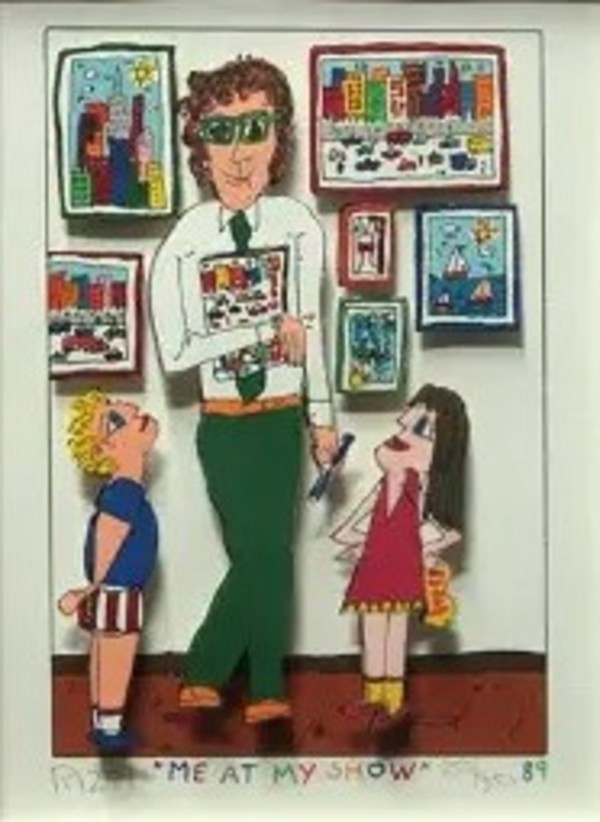-
Artist: James Rizzi (American, 1950-2011)
James Rizzi
“James Rizzi (born 1950) was a Pop Street Artist born in Brooklyn, New York and raised by a family with Irish and Italian roots.” (1)
“He grew up in Brooklyn and attended the Holy Innocents Grammar School, and later the Erasmus High School. Rizzi was often described as a man of sun full character, who knew how to cheer himself up and pick up the spirits among others. After high school, he took a leap year, which turned out to last more than just a year, but the break period turned out to be very beneficial for his art and creativity.” (2)
“James Rizzi went to the University of Florida (Gainesville) to study business, but quickly changed majors to fine art. It was there that he began experimenting with a style that incorporated three techniques, painting, printmaking and sculpture. His goal was to create artwork that was three-dimensional but not like free standing [sic] traditional sculpture. His intricate works consisted of carefully cut-out and attached elements, which created a rich, busy composition.” (1)
“James Rizzi became famous for the 3D paper sculptures he invented, the playful and childlike forms and bright colors of which were to become his artistic trademark. Thus he acquired a large international following across all age groups and classes.” (3)
“His large panorama of Urban life are teeming with energy and life, reflecting all the diversity and human variety that is at the core on [sic] New York. There is not ‘mean’ streets but uproariously happy ones, where children jump rope, shoot baskets and walk their dogs. If the sidewalks belong to the young people, grown ups, especially men, are imprisoned inside an army of automobiles. The vehicles are as diverse as and crazily idiosyncratic as the people who drive them.” (4)
“While making his name as a street artist, James Rizzi settled in the Soho district of Manhattan in 1975, where he spent the rest of his life. At this point in his career he reached his audience by participating in outdoor art shows in Brooklyn Heights and Washington Square, and sold pictures outside the Museum of Modern Art and the Metropolitan Museum of Art. Rizzi’s celebrant artwork of New York during this period often featured specific landmarks and businesses of the time. Injecting these cultural landmarks of the downtown scene gave his work an extra layer of vibrancy and dynamism.” (1)
“His first creations were done in small formats, and he mastered the small-scale drawings, which he started exhibiting in the city. The first exhibition happened in 1976 in Brooklyn Museum. Later came the commission design works, and vinyl case design which he did for many discos and new wave bands in the 80’s.” (2)
“In 1987, a Japanese television station produced a film about James Rizzi. He was the official artist for the 1996 Summer Olympics in Atlanta. He created a series of paintings of the opening ceremony that are now in the Olympic Museum in Lausanne, Switzerland.” (1)
“Mr. Rizzi’s creations included images for German postage stamps and a tourist guide to New York published this year. He was the official artist for...the Montreux Jazz Festival in Switzerland and soccer’s World Cup in France.” (4)
“He proudly stated out that his favorite artists were Picasso, Paul Klee, Keith Haring, Andy Warhol, and painters from the cartoon producing studios, who knew how to lighten up someone’s day and make imaginary worlds closer to the audience. His elaborative style crossed borders and traveled worldwide, but made him a superstar in Germany...Rizzi designed toys, boxes, gift wrappings and office interiors. He designed an oval ceiling, nowadays called The Rizzi Dome for the large shopping mall, in Oberhausen, Germany. For the Volkswagen Beetle, he painted and decorated three cars, and for the Lufthansa Boeing 757, he designed the whole exterior.” (2)
“There were a number of significant books published about James Rizzi throughout his career. In 1988, the first book about Rizzi was published: ‘James Rizzi - 3D Constructions’. The second book about Rizzi was published in 1992 by Glenn O'Brien called ‘Rizzi’. In 1996. an impressive monograph, ‘The New York Paintings’, revealed Rizzi's passion for his native city. His last major book was in 2006 titled ‘James Rizzi. Artwork 1993-2006’.” (1)
“In New York, he created a limited-edition of the MetroCard subway fare-paying system, and his designs appeared in “CowParade,” an exhibit of fiberglass sculptures shown in New York public spaces. He enjoyed some of his biggest successes in Germany and Asia, designing china, the front page of a newspaper in Hamburg and some vehicular art — a toy-size fire engine and three versions of the 1999 Volkswagen New Beetle.” (4)
“The world famous pop artist died peacefully in his sleep in his studio in SoHo, New York, the night after Christmas. His sudden and unexpected death comes as a shock to family, friends, and collectors alike.” (3)
“He died in 2011.” (1)
Reference
1. Beloosesky Gallery Staff. James Rizzi [internet]. New York, NY: Beloosesky Gallery [cited 2020 Jan 6]. Available from: https://www.beloosesky.com/artists/james-rizzi?view=slider#3
2. Cuddy, D. James Rizzi [internet]. Widewalls [cited 2020 Jan 6]. Available from: https://www.widewalls.ch/artist/james-rizzi/
3. Askart Staff. James Rizzi [internet]. [cited 2020 Jan 6]. Available from: https://www.askart.com/artist_bio/James_Rizzi/101301/James_Rizzi.aspx
4. Ro Gallery Staff. James Rizzi, American (1950-2011) [internet]. Long Island City, NY: Ro Gallery [cited 2020 Jan 6]. Available from: https://rogallery.com/Rizzi_James/rizzi-bio.htm
